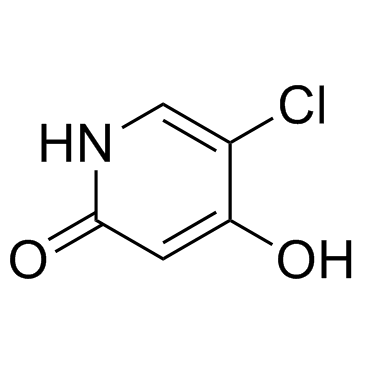
Gimeracil
CAS No. 103766-25-2
Gimeracil( Gimestat )
Catalog No. M10190 CAS No. 103766-25-2
An inhibitor of dihydropyrimidine dehydrogenase, degrades pyrimidine including 5-fluorouracil in the blood.
Purity : >98% (HPLC)
 COA
COA
 Datasheet
Datasheet
 HNMR
HNMR
 HPLC
HPLC
 MSDS
MSDS
 Handing Instructions
Handing Instructions
| Size | Price / USD | Stock | Quantity |
| 25MG | 46 | In Stock |


|
| 50MG | 61 | In Stock |


|
| 100MG | 81 | In Stock |


|
| 200MG | 99 | In Stock |


|
| 500MG | 118 | In Stock |


|
| 1G | Get Quote | In Stock |


|
Biological Information
-
Product NameGimeracil
-
NoteResearch use only, not for human use.
-
Brief DescriptionAn inhibitor of dihydropyrimidine dehydrogenase, degrades pyrimidine including 5-fluorouracil in the blood.
-
DescriptionAn inhibitor of dihydropyrimidine dehydrogenase, degrades pyrimidine including 5-fluorouracil in the blood; inhibits homologous recombination. Chemotherapeutic Agents Approved(In Vitro):Gimeracil reduces the frequency of neo-positive clones. Additionally, it sensitized the cells in S-phase more than in G0/G1.Gimeracil may enhance the efficacy of radiotherapy through the suppression of HR-mediated DNA repair pathways.Gimeracil pretreatment significantly restrains the formation of radiation-induced foci of Rad51 and RPA, whereas it increased the number of foci of Nbs1, Mre11, Rad50, and FancD2. (In Vivo):Gimeracil (2.5-25 mg/kg, orally) may inhibit the rapid repair of X-ray-induced DNA damage in tumors.
-
In Vitro——
-
In VivoAnimal Model:Nude mice (Lu-99, LC-11, KB/C3 and PAN-4 tumors were xenografted).Dosage:2.5-25 mg/kg.Administration:Orally.Result:Exhibited anti-tumor activity.
-
SynonymsGimestat
-
PathwayOthers
-
TargetOther Targets
-
RecptorDHPS
-
Research AreaCancer
-
IndicationChemotherapeutic
Chemical Information
-
CAS Number103766-25-2
-
Formula Weight145.5438
-
Molecular FormulaC5H4ClNO2
-
Purity>98% (HPLC)
-
SolubilityDMSO: 29 mg/mL
-
SMILESO=C1C=C(O)NC=C1Cl
-
Chemical Name2(1H)-Pyridinone, 5-chloro-4-hydroxy-
Shipping & Storage Information
-
Storage(-20℃)
-
ShippingWith Ice Pack
-
Stability≥ 2 years
Reference
molnova catalog



related products
-
Riddelline
Riddelline is a potent genotoxic agent in vitro and induces significant elevations in unscheduled DNA synthesis and S-phase synthesis in rat liver.
-
DL-Metanephrine-d3 H...
DL-Metanephrine-d3 Hydrochloride is L-Metanephrine labeled with deuterium atoms and can be used to study the metabolic flow of L-Metanephrine in the body.
-
W-2429
W-2429 (NSC294836) is a non-narcotic analgesic that may be used in the study of neurological disorders.



 Cart
Cart
 sales@molnova.com
sales@molnova.com


